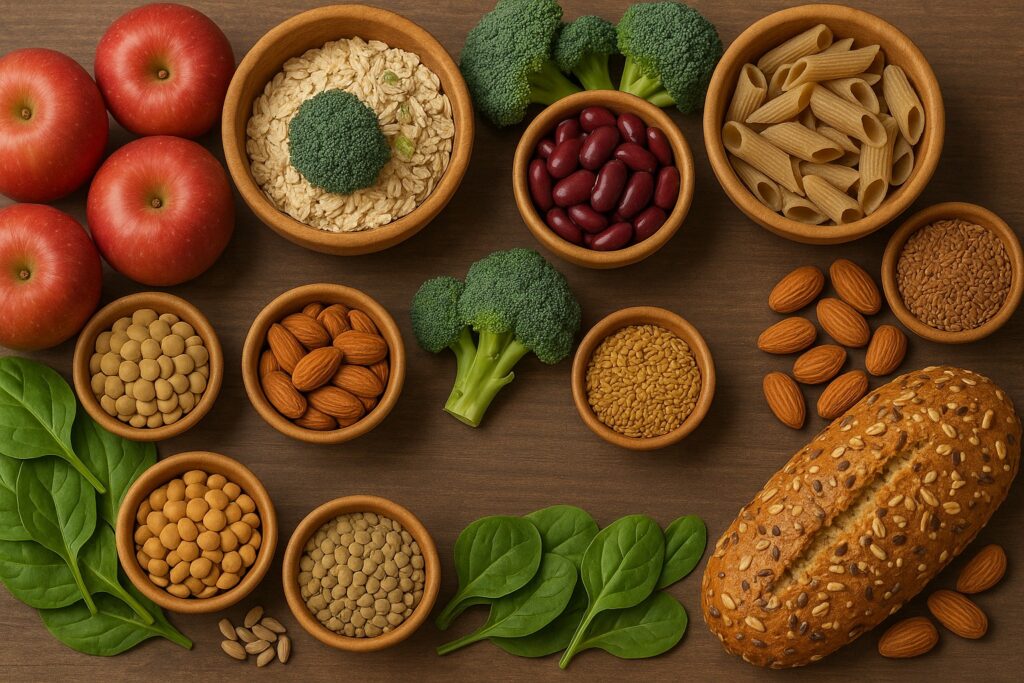Feed Your Microbes with Fiber
Fiber is one of the most critical yet often overlooked components of a healthy diet. Despite its simplicity, fiber plays a profound role in disease prevention, digestion, and overall wellness.
The History of Fiber in Human Diets
- Ancient Civilizations: Early humans were hunter-gatherers who consumed plenty of fibrous plant foods like roots, nuts, seeds, and fruits.
- First Agricultural Revolution (c. 10,000 BCE): As agriculture evolved, diets became more grain-based, further increasing fiber intake through whole grains, legumes, and vegetables.
- Industrial Revolution (18th–19th centuries): Processing methods like milling removed fiber from grains to produce white flour, causing a steep drop in dietary fiber intake.
- 20th Century: Chronic diseases such as heart disease, type 2 diabetes, and colorectal cancer surged in Western countries, leading researchers to investigate the protective role of fiber.
- Today: Despite overwhelming evidence of fiber’s health benefits, most modern diets are dangerously low in fiber, especially in developed nations.
What Is Fiber?
Dietary fiber refers to the indigestible parts of plant foods. Unlike fats, proteins or carbohydrates, fiber is not broken down and absorbed by the body. Instead, it passes relatively intact through the stomach, small intestine, and colon, performing essential functions along the way.
There are two primary types of fiber:
Soluble Fiber:
Dissolves in water, forming a gel-like substance. Found in oats, beans, apples, and citrus fruits.
Insoluble Fiber:
Does not dissolve in water. It adds bulk to the stool and aids in digestion. Found in whole grains, nuts, and vegetables.
The Incredible Health Benefits of Fiber
Digestive Health
Fiber normalizes bowel movements by increasing stool bulk and promoting regularity. It also helps to prevent constipation, hemorrhoids and diverticulitis.
Heart Health
Soluble fiber helps lower total blood cholesterol levels by binding to cholesterol particles and removing them from the body. A high-fiber diet is associated with a lower risk of heart disease, stroke and hypertension.
Blood Sugar Control
Soluble fiber in particular slows the absorption of sugar, improving blood sugar levels. It helps to manage and prevent Type 2 diabetes and metabolic syndrome.
Weight Management
High-fiber foods are more filling, helping to curb appetite and support healthy weight loss or maintenance.
Cancer Prevention
A diet high in fiber is linked to a reduced risk of colorectal cancer. Fiber promotes gut health by feeding beneficial gut bacteria, producing short-chain fatty acids (SCFAs) that may protect against cancer.
Gut Microbiome Health
Fiber acts as a prebiotic, nourishing the trillions of beneficial bacteria living in the gut. A healthy gut microbiome is associated with stronger immunity, better mood and cognitive function as well as reduced inflammation.
The Risks of Low (and Excessive) Fiber Intake
While fiber has many benefits, both too little and too much fiber can cause health issues.
Risks of Low Fiber Intake
A lack of dietary fiber is linked to:
- Constipation and digestive disorders
- Increased risk of heart disease
- Poor blood sugar control
- Weight gain
- Higher inflammation levels
Recommended Daily Fiber Intake:
- Women: 25 grams/day
- Men: 38 grams/day
Modern diets are rich in processed foods and low in fruits, vegetables and whole grains. The average American consumes only about 15 grams/day, far below the target.
Risks of Excessive Fiber Intake
While rare, consuming too much fiber — especially too quickly — can cause:
- Bloating
- Gas
- Cramping
- Diarrhea
- Nutrient malabsorption (in extreme cases)
Sources of Dietary Fiber
To maximize the health benefits of fiber, it is best to incorporate a diverse range of fiber-rich foods:
Food Group | Examples |
Whole Grains | Oats, quinoa, brown rice, barley |
Legumes | Lentils, black beans, chickpeas |
Fruits | Apples, berries, pears, bananas |
Vegetables | Broccoli, carrots, spinach, artichokes |
Nuts and Seeds | Almonds, chia seeds, flaxseeds |
Tips to Increase Fiber Intake
- Start Slow: Gradually introduce more fiber into your meals to allow your digestive system to adapt.
- Stay Hydrated: Water helps fiber move smoothly through your digestive system.
- Eat Whole Foods: Choose whole fruits, vegetables, legumes, and grains instead of processed options.
- Read Labels: Look for products with at least 3–5 grams of fiber per serving.
- Mix It Up: Incorporate both soluble and insoluble fiber sources for comprehensive benefits.
Fiber-Rich Meal Ideas
- Overnight oats with chia seeds, blueberries, and almond butter
- Lentil and vegetable soup with whole grain bread
- Quinoa salad with black beans, avocado, and roasted vegetables
- Smoothies with spinach, flaxseeds, and berries
Final Thoughts
- Fiber isn’t just about digestion; it’s a powerful ally in the prevention and management of many chronic conditions.
- A diet abundant in whole, plant-based foods ensure you receive both the soluble and insoluble fibers needed to thrive.
- Prioritize colorful fruits and vegetables, hearty whole grains, legumes, and nuts.
